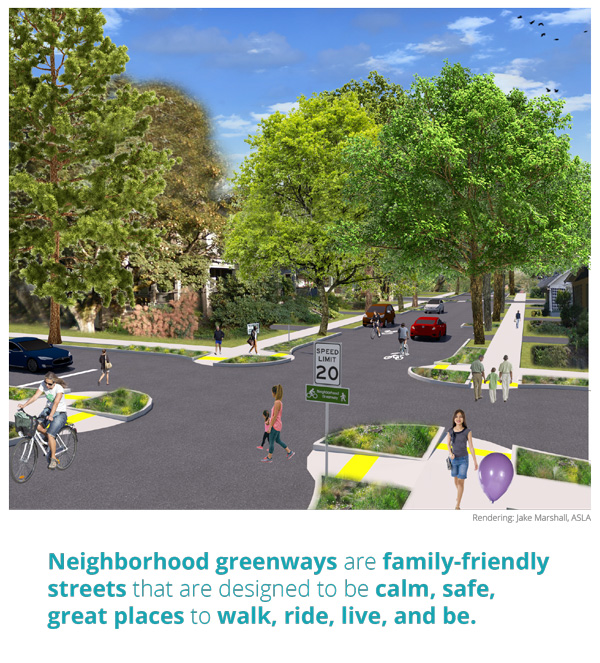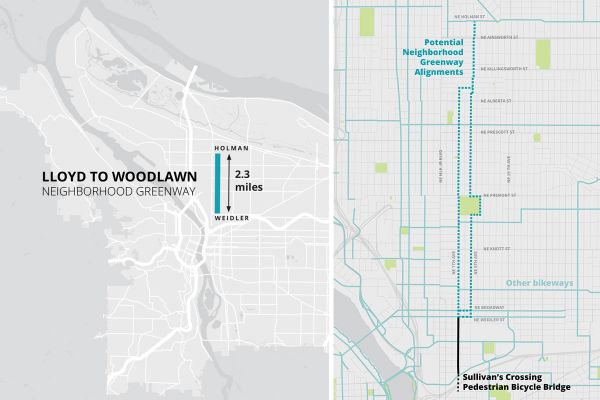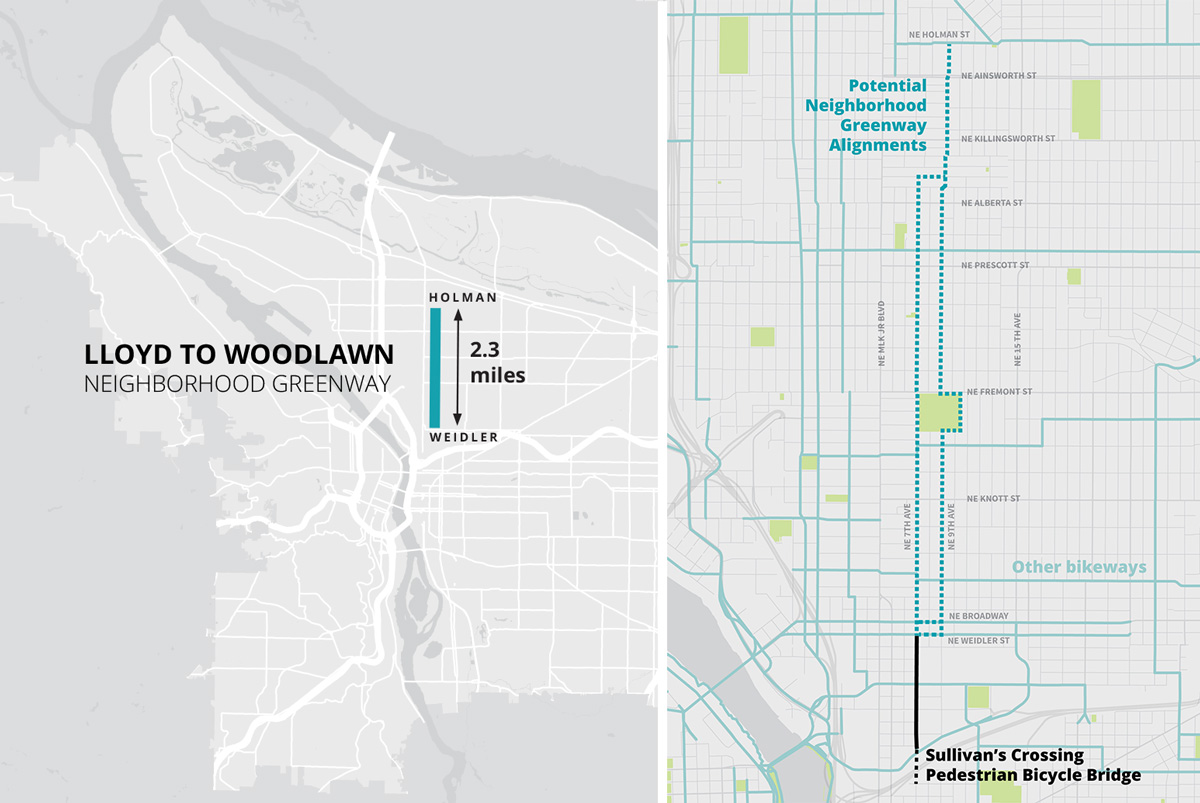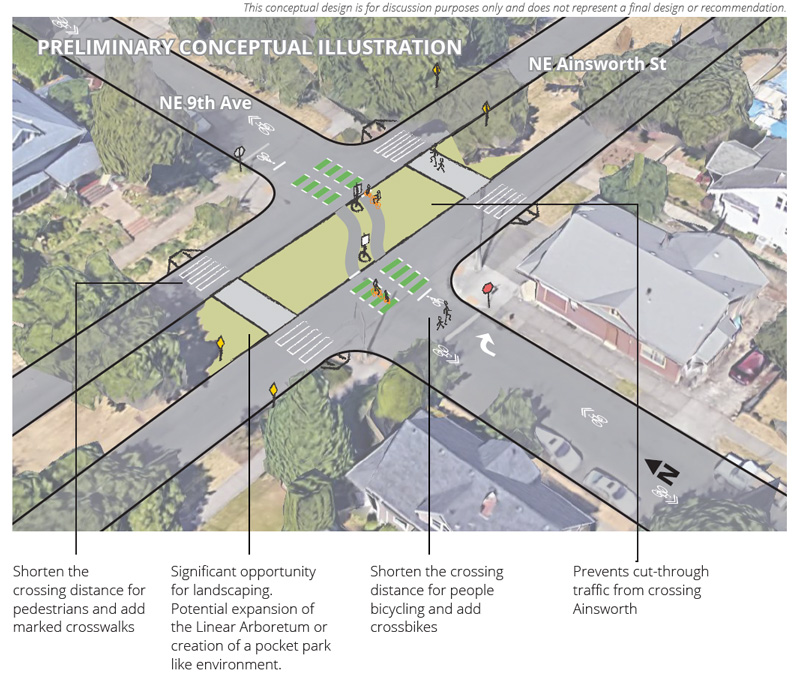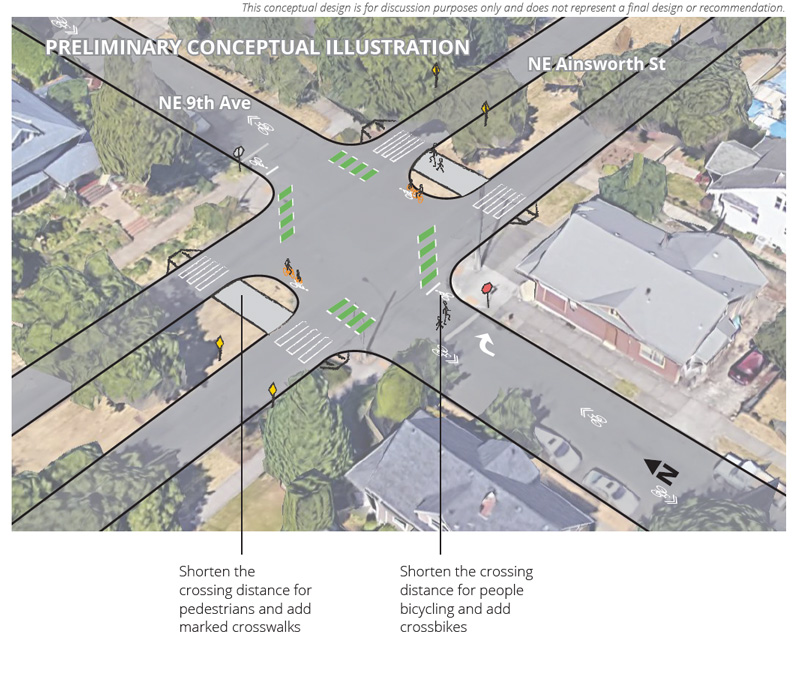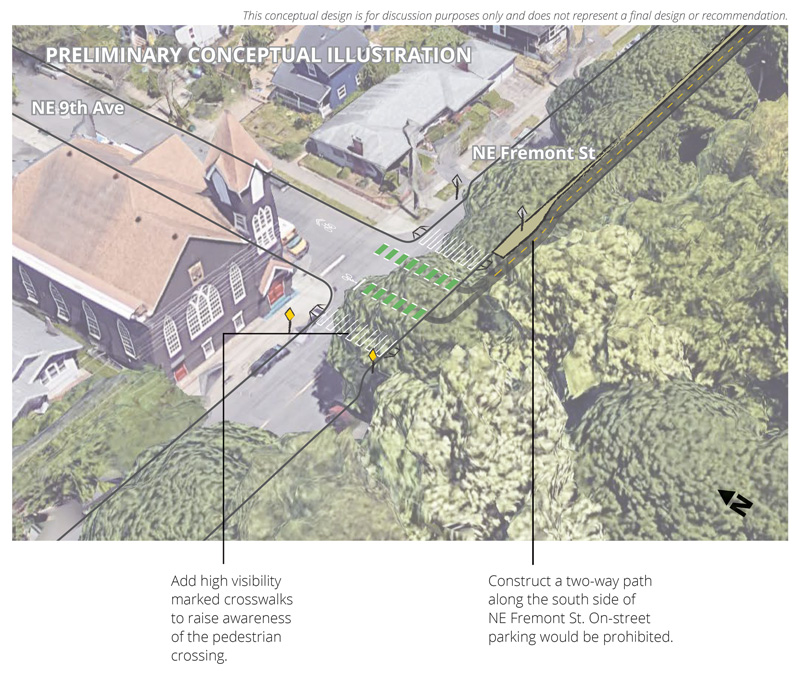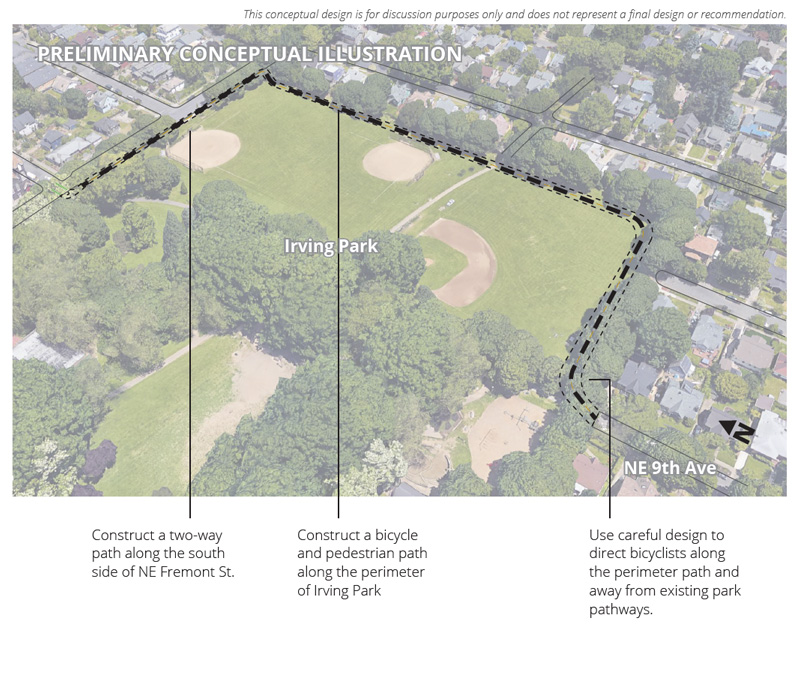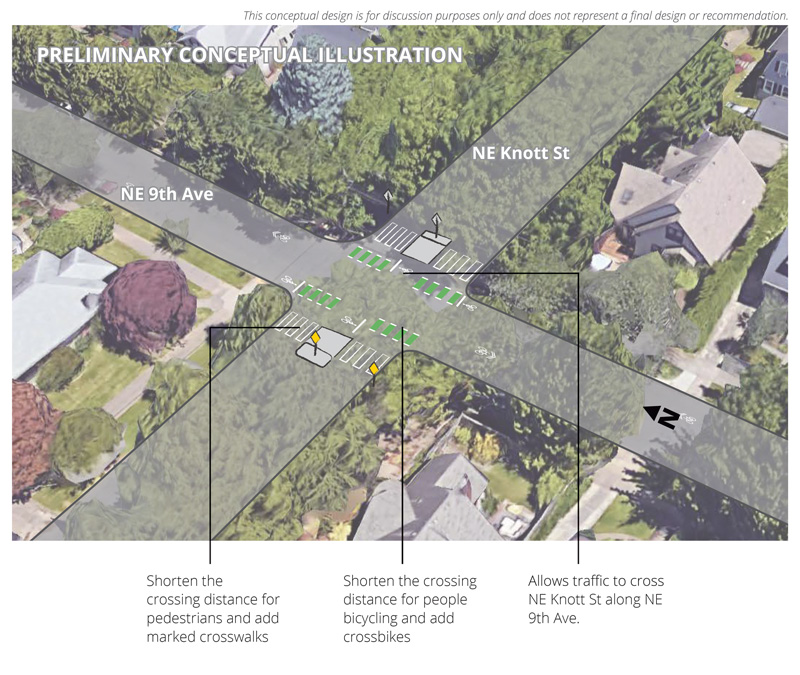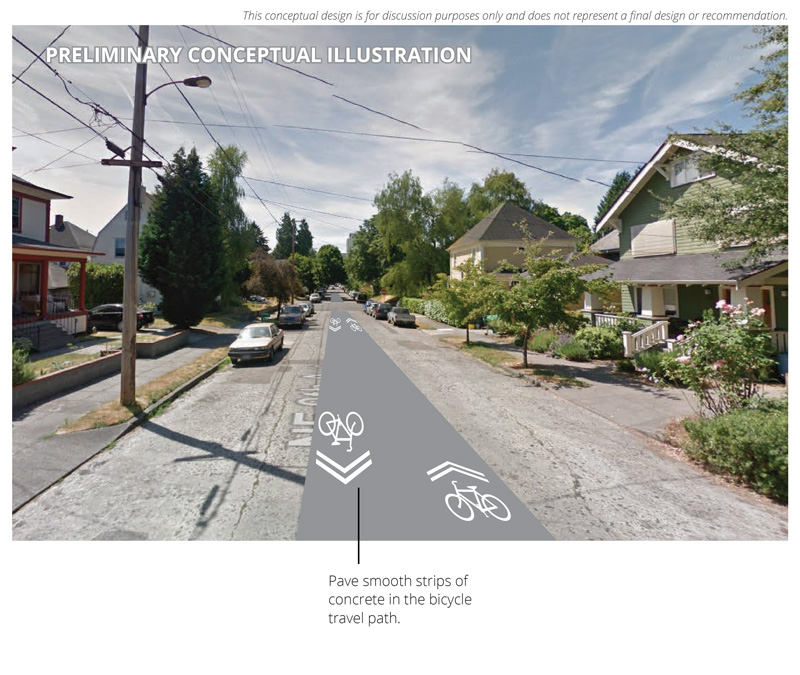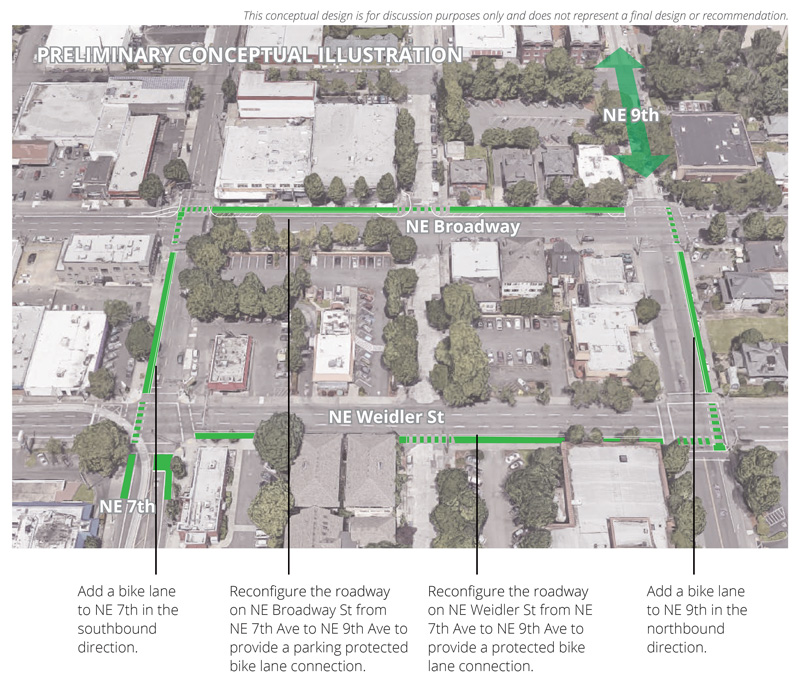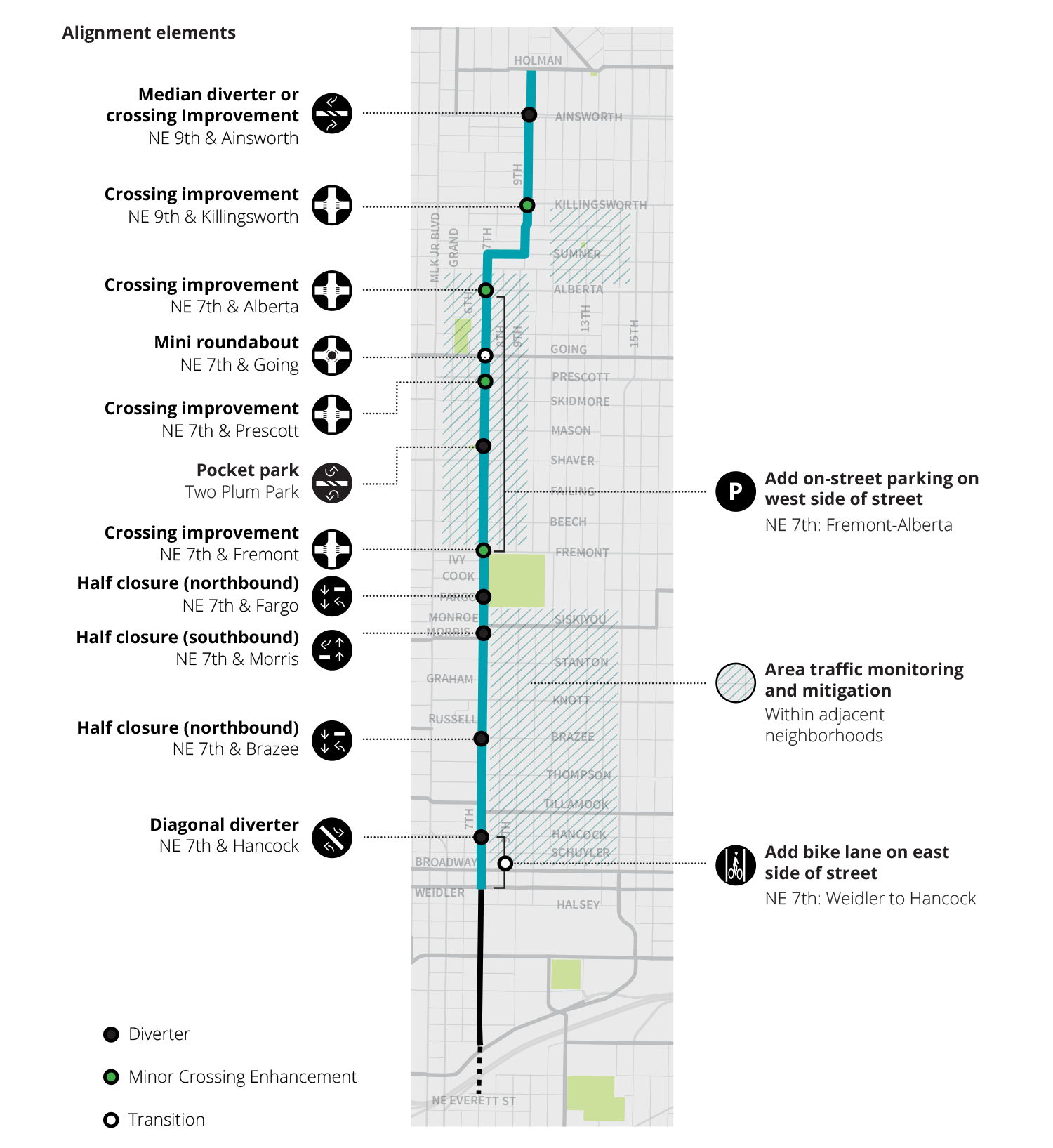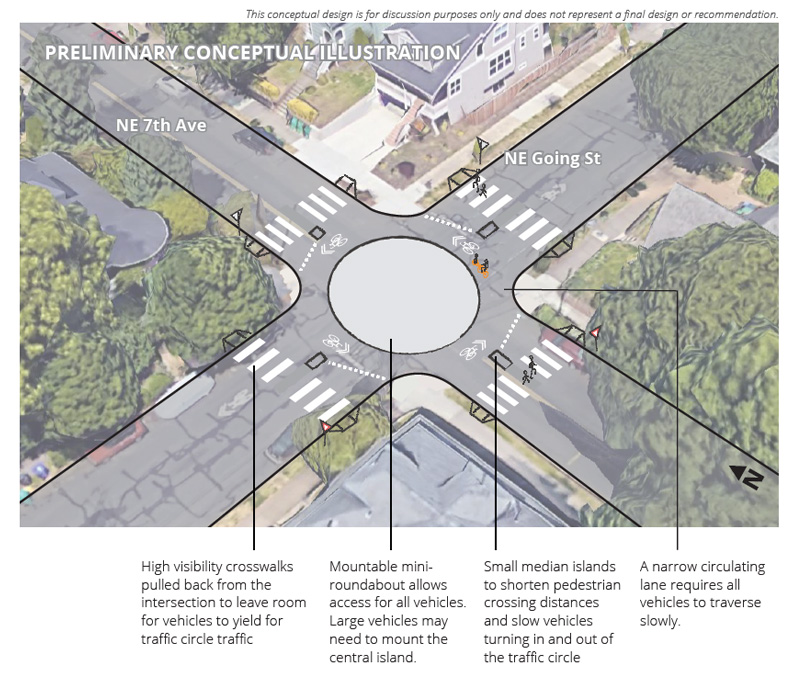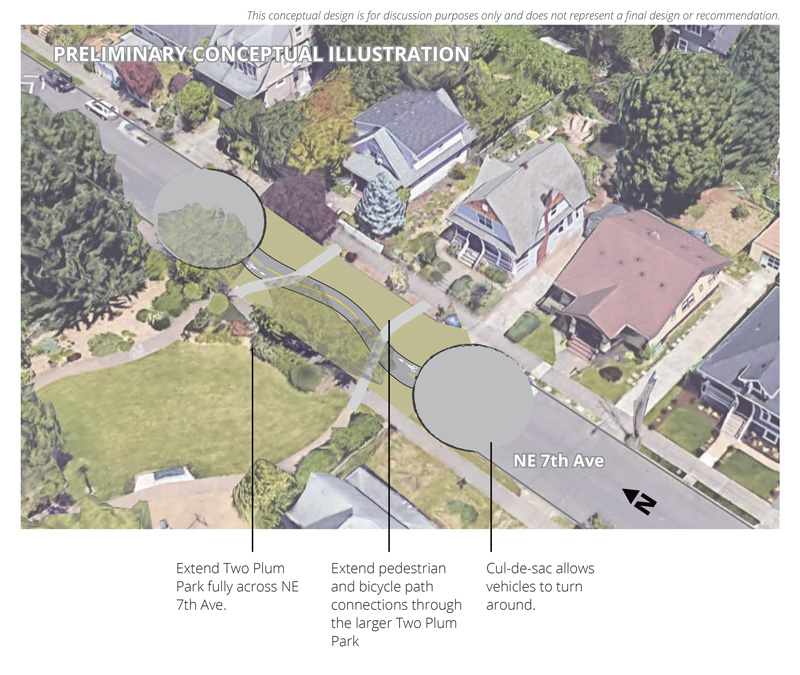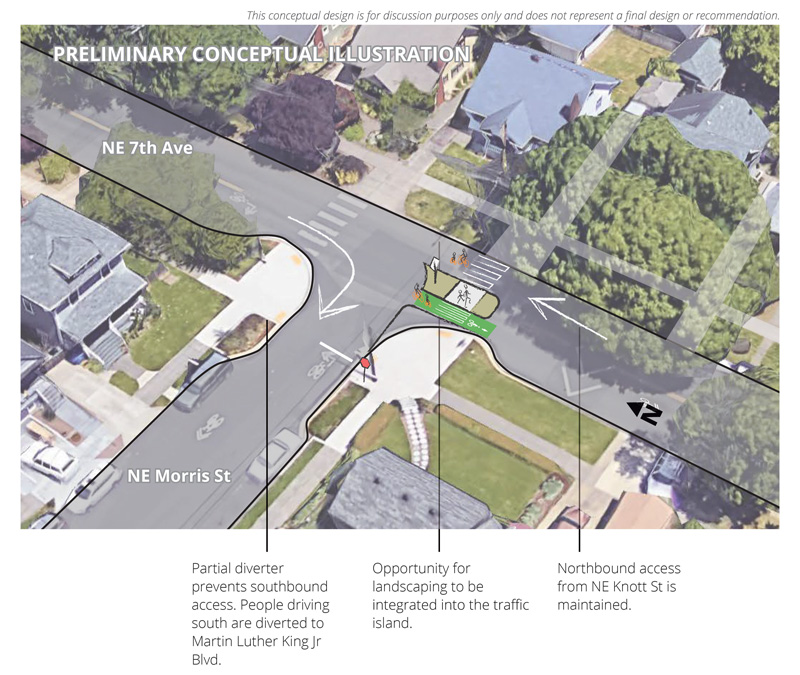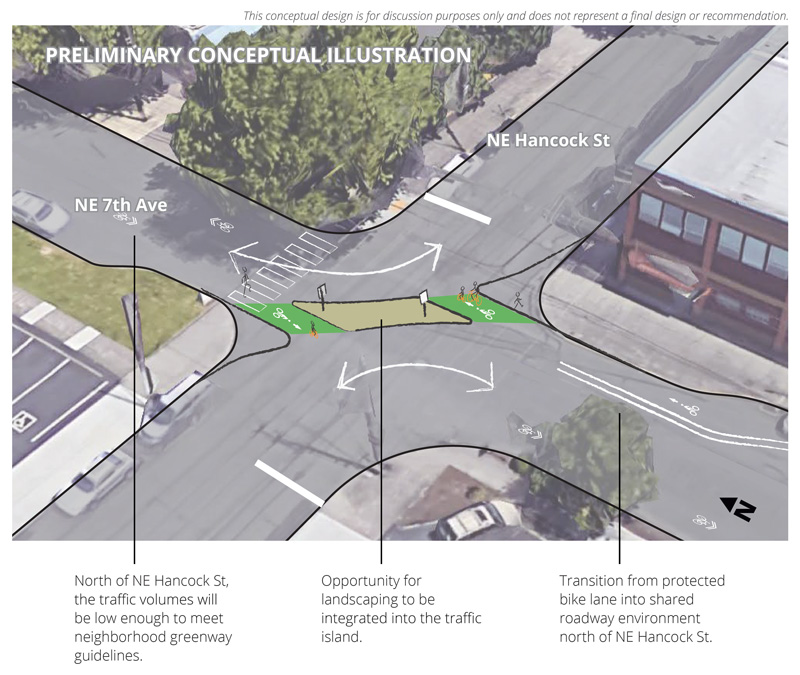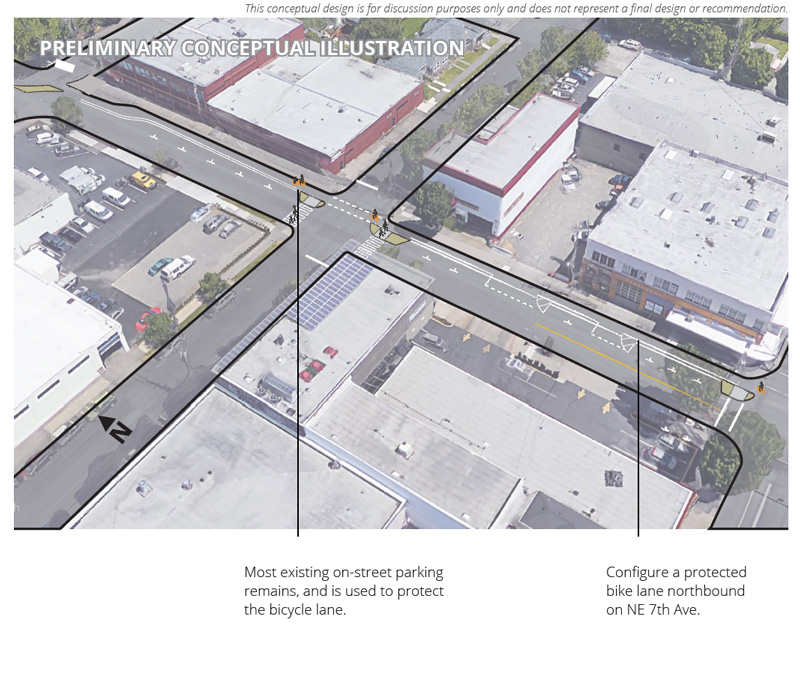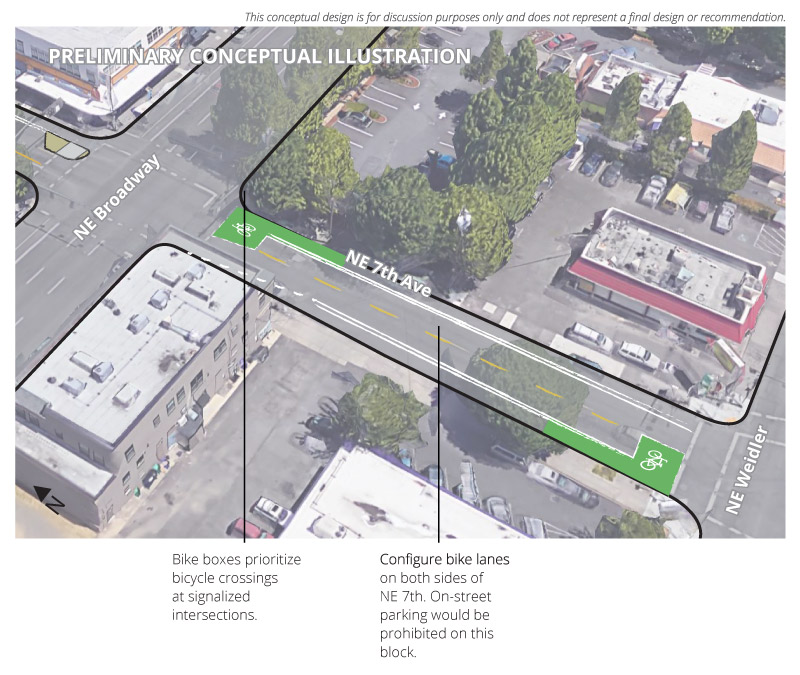Project Information
- LLoyd to Woodlawn Neighborhood Greenway Design Concept SketchBook and Initial Route Analysis (PDF, 24 MB)
Stations
Go directly to a station using the buttons below, or at the top of the screen to move through the stations in order.
= Page includes questions or opportunities for comment.
Upcoming Events
July 7, (10 am - 2 pm)
Woodlawn Farmers Market (NE Dekum St & NE Durham Ave)
July 10, (6pm - 8pm)
Portland Bicycle Advisory Commitee (City Hall, 1221 SW 4th Ave, Lovejoy Room)
July 13, (4pm - 6pm)
Irving Park (Central Plaza by the Dog Park)
July 19, (8 am - Noon)
Coffee Talk with PBOT (TwentySix Café, 2723 NE 7th Ave)
July 25, (8 am - Noon)
Coffee Talk with PBOT (Cafe Eleven, 435 NE Rosa Parks Way)
August 1 (5:30pm - 7:30pm)
Open House Event (Augustana Lutheran Church 2710 NE 14th Ave)
Stay tuned! More events to come.
Overview
Neighborhood greenways are residential streets engineered for slow travel speeds, reduced motor vehicle volumes, and safe crossings of busy streets. Two primary route options for the Lloyd to Woodlawn Neighborhood Greenway include NE 9th or NE 7th Ave in Northeast Portland. The project team is exploring both option, and the final route may be a combination of the two streets.What We've Heard
In February and March 2018, PBOT held an in-person and Online open house focused on listening and learning from the community about the Lloyd to Woodlawn Neighborhood Greenway project. The events had 361 participants, leaving 256 map-based comments and 322 complete surveys.
March Open House Feedback: How do you feel about each potential enhancement?
A NE 9th Ave
Neighborhood Greenway with
traffic calming on NE 7th Ave
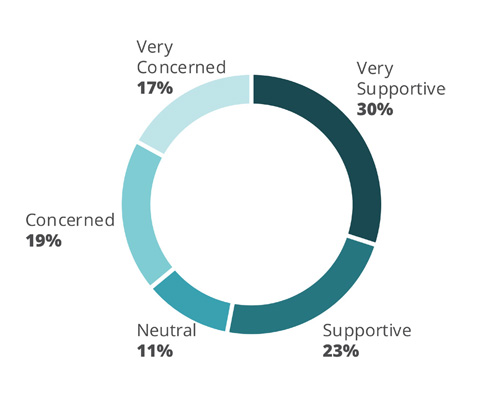
The proposal for the Neighborhood Greenway on 9th received mixed results. Many participants indicated they would still bike on NE 7th if NE 9th was a designated neighborhood greenway, but there is also some agreement that an improved bikeway on NE 9th Ave would be great for the neighborhood. Those that prefer NE 9th Ave like this option because there are fewer existing traffic issues compared to NE 7th Ave, and it’s already a safe, slow and quiet environment.
The key concerns participants indicated about NE 9th are the poor pavement conditions, steep hills, and circuitous route. There’s substantial concern around integrating bicycle traffic with Irving Park. Many participants are concerned that it will disrupt the existing pedestrian activity.
A NE 7th Ave
Neighborhood Greenway with
area traffic mitigation
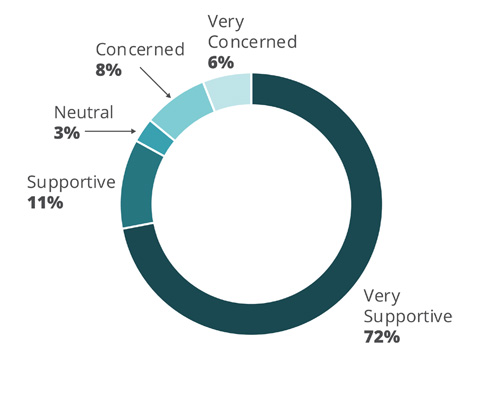
The majority of participants were very supportive of building the neighborhood greenway on NE 7th Ave with additional monitoring and mitigation of traffic in the area. Supporters for the NE 7th alignment mentioned that it’s a direct connection to Lloyd District, the planned Sullivan’s Crossing I-84 pedestrian bridge, and other destinations, and addresses traffic issues on NE 7th, i.e. reduces cut-through traffic and speeding drivers.
However, there was concern about traffic spilling over to other side streets to avoid Martin Luther King Jr Blvd and questions about how that could be mitigated.
Many community members want PBOT to further explore design options on NE 7th.
People cited the ability to provide direct connections to destinations, proximity to Martin Luther King Jr. Blvd, and the opportunity to calm traffic on an important safe routes to school connection.
Businesses are concerned about changes which impact direct access to their property.
Traffic diverters are often located at the intersection of collector and arterial streets, where businesses are also located. PBOT engineers have identified an alternative approach to diversion which locates diverters internal to neighborhoods to minimize business access impacts.
There are concerns about whether Martin Luther King Jr Blvd and other arterial streets can handle the relocated traffic associated with the NE 7th option.
Early engineering assessment suggests that outside of rush hour, traffic can be easily accommodated on adjacent arterial streets. Engineers are exploring strategies and enhancements to support the relocated traffic during peak demand periods.
Neighbors are concerned about spillover effects of traffic patterns changes as a result of a NE 7th option.
PBOT takes concerns of spillover traffic seriously. The specific designs and locations for traffic pattern changes are selected to redirect traffic to appropriate arterial and collector streets, and to minimize any direct spillover into the neighborhood. PBOT is committed to a robust pre- and post- data collection and analysis effort to identify any unsafe traffic pattern changes resulting from this project.
Objectives of our traffic control changes
- Enhance crossings to create safer conditions and encourage high yielding rates
- Reduce motor vehicle volumes and speeds to achieve neighborhood greenway guidelines
- Prioritize access and circulation for businesses
- Minimize neighborhood cut through traffic
- Direct diverted traffic to arterial routes
Other corridor-wide enhancements
In addition to specific changes at key intersections, Neighborhood Greenways include additional standard treatments applied along the full corridor. The location of these elements are not identified yet, but will be included in any final alignment design. These enhancements include:
- Shared lane markings
- Speed humps
- Stop sign re-orientation
- Wayfinding signs
Characteristics of Neighborhood Greenway Projects

Safer Street Crossings
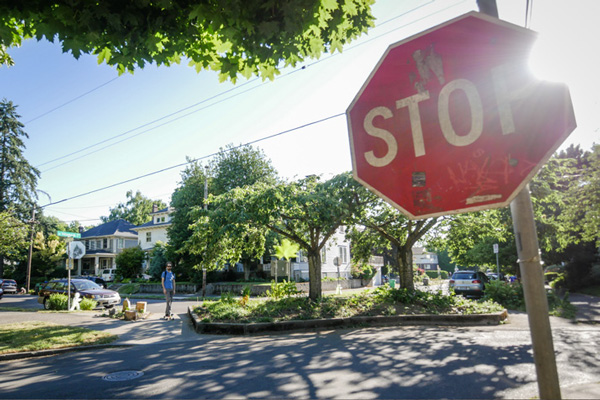
Few Cars, Many People
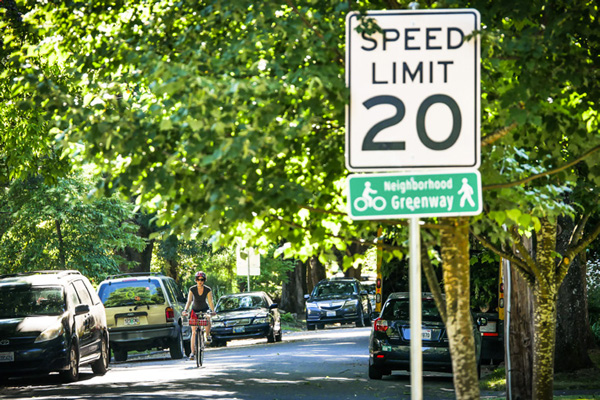
Walking Friendly Speeds
Key Design elements
Engineering a neighborhood greenway on NE 9th emphasizes speed reduction and crossing enhancements.
- Speed humps would be used to reduce speeds to under 20 mph.
- Crossings would be upgraded with high visibility crossings.
- Where necessary for safety, crossings will use median islands or curb extensions to reduce exposure to traffic.
- Some crossing enhancements may limit traffic movements.
- A new path through Irving Park would provide a safe connection, away from high-activity park areas.
- Consideration for treating the poor pavement quality south of NE Thompson St.
Irving Park considerations
Irving Park is an important site in our citywide park system. Established in the 1920s and upgraded in the 1970s, community members travel to the park for outdoor activities such as tennis, basketball and field sports. Irving Park provides a dog off leash area which is well used by the surrounding neighborhoods. The addition of a pathway through Irving park would be designed to separate bicyclists from competing active uses, and would feature elements to minimize impacts to adjacent residential properties.
Includes minor traffic calming on NE 7th
Community surveys have indicated that many bicyclists would continue to use NE 7th even if NE 9th is engineered as a Neighborhood Greenway. If this option is selected, NE 7th will receive some level of traffic calming and traffic reduction, but not enough to meet our guidelines for neighborhood greenway conditions.
Review the conceptual designs below, and provide feedback.
NE 9th Conceptual Designs
Irving Park considerations
Irving Park is an important site in our citywide park system. Established in the 1920s and upgraded in the 1970s, community members travel to the park for outdoor activities such as tennis, basketball and field sports. Irving Park provides a dog off leash area which is well used by the surrounding neighborhoods. The addition of a pathway through Irving park would be designed to separate bicyclists from competing active uses, and would feature elements to minimize impacts to adjacent residential properties.
Includes minor traffic calming on NE 7th
Community surveys have indicated that many bicyclists would continue to use NE 7th even if NE 9th is engineered as a Neighborhood Greenway. If this option is selected, NE 7th will receive some level of traffic calming and traffic reduction, but not enough to meet our guidelines for neighborhood greenway conditions.
Design Option A
The tree-lined median along NE Ainsworth St, also known as the Ainsworth Linear Arboretum, offers a unique opportunity to enhance the crossing while expanding a community resource. This design does prohibit some traffic movements.
Questions
Key Design elements
Engineering a neighborhood greenway on NE 7th emphasizes volume reduction, along with speed reduction measures.
- Traffic diverters would be used strategically to re-direct cut through traffic back to appropriate arterial streets, such as Martin Luther King Jr Blvd.
- Access for neighbors and businesses would be maintained. Specific traffic routes to these destinations may need to change slightly to accommodate the new traffic diverters.
- Speed humps will be used to reduce speeds to under 20 mph
- Crossings will be upgraded with high visibility crossings and paired with median islands, or curb extensions to reduce exposure to traffic. Where possible, the crossing will maintain and enhance the existing traffic signals to prioritize walking and bicycling.
- Where traffic volumes cannot be lowered, a bicycle lane provides a separated place to bicycle away from traffic.
Monitoring and mitigation of neighborhood impacts
Community surveys and communication indicate a high level of concern about spillover effects of traffic diversion. The project engineers take such concerns seriously, and designs are selected on their ability to re-direct traffic to appropriate locations and discourage unwanted entrance into other neighborhood streets.
If this alignment is recommended, PBOT commits to monitoring neighborhood traffic conditions for unsafe changes and mitigating those traffic impacts. Mitigation includes traffic calming at the affected area, or modification of the design to resolve the impact.
Review the conceptual designs below, and provide feedback.
NE 7th Conceptual Designs
Monitoring and mitigation of neighborhood impacts
Community surveys and communication indicate a high level of concern about spillover effects of traffic diversion. The project engineers take such concerns seriously, and designs are selected on their ability to re-direct traffic to appropriate locations and discourage unwanted entrance into other neighborhood streets.
If this alignment is recommended, PBOT commits to monitoring neighborhood traffic conditions for unsafe changes and mitigating those traffic impacts. Mitigation includes traffic calming at the affected area, or modification of the design to resolve the impact.
Design Option A
The tree-lined median along NE Ainsworth St, also known as the Ainsworth Linear Arboretum, offers a unique opportunity to enhance the crossing while expanding a community resource. This design does prohibit some traffic movements.
Questions
Initial results indicate the NE 7th alignment best meets the objectives of the project, but would require careful design of traffic pattern changes and close monitoring of traffic conditions.
PBOT staff performed a preliminary analysis for both routes based on the criteria listed above. This analysis does not prescribe the final route selection, but it is an important step in understanding which route best meets our project objectives. The final decision will be made after considering and incorporating feedback collected from community engagement events, through communication with neighborhood organizations, and continued discussion with adjacent neighbors and businesses.
PBOT evaluates neighborhood greenway routes on a variety of performance factors. See the Analysis Table for detailed results of the Intial Route Analysis.
NE 7th Route Evaluation
Neighborhood Greenway Performance
User Experience
Traffic Impacts
Policy Support
Cost Effectiveness
NE 9th Route Evaluation
Neighborhood Greenway Performance
User Experience
Traffic Impacts
Policy Support
Cost Effectiveness
Questions
How will we decide?
We are considering public feedback from:
- Testimony and comments from community briefings, meetings and events
- Information gathered at the July open house event
Many attributes influence the benefits, usefulness and success of a neighborhood greenway. A technical analysis will evaluate our alignments on various technical criteria.
Stay Involved
- Visit the project website at www.portlandoregon.gov/transportation/L2W.
- Sign up for email updates below,
- Contact: Nick Falbo at (503) 823-6152 or nick.falbo@portlandoregon.gov.
Upcoming Events
- July 7 – 10 am-2pm - Woodlawn Farmers Market (NE Dekum St & NE Durham Ave)
- July 10 - 6- 8 pm - Portland Bicycle Advisory Committee (City Hall, 1221 SW 4th Ave, Lovejoy Room)
- July 13 – 4 pm – 6 pm – Irving Park (Central Plaza by the Dog Park)
- July 19 - 8 am – Noon – Coffee Talk with PBOT (TwentySix Café, 2723 NE 7th Ave)
- July 25 – 8 am – Noon – Coffee Talk with PBOT (Location TBD)
- August 1 – Open House Event (Augustana Lutheran Church 2710 NE 14th Ave)
- Stay tuned! More events to come.
Final Questions
Tell Us About You
Participation Demographics (Optional)
The City of Portland complies with all non‐discrimination, Civil Rights laws including Civil Rights Title VI and ADA Title II. To help ensure equal access to City programs, services and activities, the City of Portland will reasonably modify policies/procedures and provide auxiliary aids/services to persons with disabilities. Call 503-823-5185, TTY 503-823-6868 or Oregon Relay Service: 711 with such requests, or visit http://bit.ly/13EWaCg.

